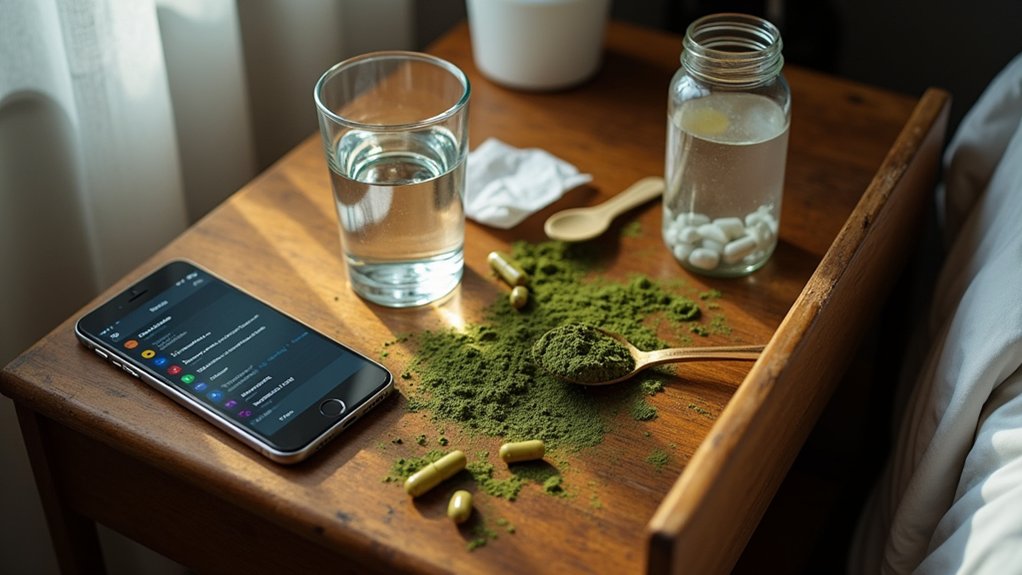Early signs of kratom addiction can appear in both physical and behavioral changes. You’ll notice sleep disruptions, unexplained energy fluctuations, and gastrointestinal issues like nausea or cramping. Watch for increasing social withdrawal, neglect of responsibilities, and failed attempts to control usage. Physical symptoms often include dry mouth, muscle aches, and pin-point pupils. If you’re experiencing tolerance or withdrawal symptoms when stopping use, these could indicate developing dependence. Understanding the full scope of warning signs can help you make informed decisions about your health.
Physical Warning Signs and Symptoms

While kratom’s effects may initially seem benign, physical warning signs of addiction often manifest through distinct patterns of physiological changes. You’ll notice significant sleep disturbances, ranging from insomnia to excessive drowsiness, depending on dosage levels. Watch for unexplained energy fluctuations and increased talkativeness during use, followed by profound fatigue during non-use periods. The euphoric feelings from opioid-like effects can mask developing addiction symptoms.
Gastrointestinal issues are particularly telling indicators. You may experience persistent nausea, vomiting, and abdominal cramping, along with irregular bowel movements. Pay attention to unexpected weight changes and decreased appetite. Users commonly report experiencing dry mouth and dizziness as early warning signs. Other warning signs include muscle aches, tremors, and pin-point pupils. You might also notice respiratory changes, with shallow breathing at higher doses, accompanied by skin changes such as pallor or clamminess. If you experience persistent symptoms, consider contacting the website’s support team for assistance. These symptoms typically intensify during withdrawal periods.
Behavioral Changes in Daily Life
As kratom addiction develops, you’ll notice distinct behavioral changes that affect multiple aspects of daily functioning. Watch for increasing social withdrawal, where you’re avoiding friends and family while choosing isolation over previously enjoyed activities. You may experience emotional detachment, displaying apathy toward relationships and becoming secretive about your daily routines. Physical hygiene decline often accompanies these behavioral shifts, leading to poor self-care habits. Mood swings and anxiety commonly emerge as psychological symptoms worsen. Similar to experiencing high traffic issues, your mind may feel overwhelmed and unable to process daily tasks effectively.
Your performance at work or school might decline, accompanied by frequent absences and missed deadlines. You’ll likely neglect household responsibilities and financial obligations. Hobbies and interests that once brought joy may be abandoned in favor of kratom use. Additionally, you might engage in risky behaviors, such as using kratom while driving or making impulsive financial decisions to obtain the substance, despite recognizing the negative impact on your life.
Loss of Control Over Kratom Use

The most telling indicator of kratom addiction manifests through a progressive loss of control over usage patterns. You’ll notice an increasing inability to regulate your consumption, marked by uncontrollable cravings and a pattern of failed attempts to reduce or quit usage.
Despite your intentions to limit intake, you may find yourself consuming larger amounts over extended periods. This loss of control typically presents through multiple unsuccessful efforts to stop, followed by relapses even when you’re aware of negative consequences. You’ll likely experience persistent urges to use kratom despite recognizing its harmful effects on your health and daily functioning.
The development of tolerance further complicates this cycle, as you’ll need progressively higher doses to achieve the same effects, making it increasingly difficult to maintain control over your consumption. Since kratom interacts with opioid receptor pathways, this progression of addiction closely mirrors the patterns seen in other substance use disorders. Approximately two million Americans have reported using kratom in the past year, highlighting the widespread potential for developing dependency.
Social and Relationship Impact
Significant changes in your social behaviors and relationships often reveal the progression of kratom addiction. You’ll notice increasing social withdrawal as you begin avoiding family gatherings, friends, and previously enjoyed activities. This isolation typically stems from shame or fear of judgment about your kratom use. Research shows that younger, male, unpartnered individuals have higher rates of kratom use and may be particularly vulnerable to social isolation. Studies indicate that approximately non-Hispanic White individuals represent 89% of kratom users, highlighting specific demographic vulnerabilities.
Your relationships may show mounting strain through frequent arguments, broken promises, and diminished emotional availability. You might find yourself neglecting important family responsibilities, missing work commitments, or struggling to maintain childcare duties. Studies indicate that moderate to severe addiction affects approximately 9.5% of regular kratom users. Financial difficulties from kratom purchases can create additional tension, leading to conflicts over money and resource allocation.
If you’re experiencing these social disruptions, they’re essential warning signs that your kratom use has evolved beyond recreational consumption into problematic territory requiring professional intervention.
Understanding Tolerance and Withdrawal

Developing tolerance to kratom serves as a critical warning sign of physical dependence, marked by your body’s diminishing response to regular doses. As tolerance levels increase, you’ll notice a need for higher amounts to achieve the same effects, often leading to a cycle of escalating use. When you stop or reduce kratom use, withdrawal symptoms typically emerge within 6-12 hours, following a predictable withdrawal timeline. Studies show that less than 10% of kratom users report withdrawal symptoms after stopping use. Many users experiencing access issues with addiction resources may need to contact security services for help reaching treatment websites. Early intervention from treatment centers can provide crucial guidance and support for those struggling with kratom dependence.
Key physical and psychological withdrawal indicators include:
- Muscle aches, sweating, and flu-like symptoms appearing within hours
- Sleep disturbances and gastrointestinal issues peaking at 1-3 days
- Anxiety, depression, and intense cravings lasting through the first week
- Psychological symptoms potentially persisting beyond the acute phase
If you’re experiencing these signs, they strongly suggest physical dependence and warrant professional medical consultation.
Frequently Asked Questions
How Long Does It Take to Develop a Kratom Addiction?
You can develop a kratom addiction within several weeks to a few months of regular use, particularly with daily consumption. If you’re using moderate to high doses, you’ll likely experience withdrawal symptoms within 6-12 hours of your last dose, indicating physical dependence. Long term effects include tolerance buildup, requiring higher doses for the same effects. Your individual factors, like genetics and mental health history, can greatly influence how quickly addiction develops.
Can Kratom Addiction Occur While Using Prescribed Amounts?
Yes, you can develop a kratom addiction even while following prescription usage guidelines. Physical dependence and tolerance can emerge despite maintaining recommended dosage limits. You’ll notice early warning signs like sleep disturbances, mood changes, and mild withdrawal symptoms between doses. Even therapeutic dosage impact can lead to psychological dependence, where you might feel preoccupied with kratom use or experience cravings. Medical supervision doesn’t eliminate addiction risk.
What Age Groups Are Most Vulnerable to Kratom Addiction?
You’re most at risk for kratom addiction if you’re between ages 12-34, with teen users ages 12-15 showing 1.70 times higher odds of use compared to older groups. Young adults under 35 have particularly heightened risks (OR=1.64), especially if you have a history of substance use disorder. You’ll find higher vulnerability among White males, and if you’re employed and living in non-metropolitan areas. Risk decreases notably after age 50.
Is Kratom Addiction More Common in People With Previous Substance Abuse?
Yes, you’re considerably more likely to develop kratom addiction if you have previous substance use disorders. The data shows that 31% of kratom users have at least one SUD, and you’re 18 times more likely to have an opioid use disorder compared to never-users. Your addiction risk increases substantially with prior substance use history, as evidenced by higher rates of polysubstance abuse and a 20-fold greater chance of developing multiple co-occurring SUDs.
Are There Genetic Factors That Increase the Risk of Kratom Addiction?
Yes, your genetic predisposition can greatly increase your risk of developing kratom addiction. If you have a family history of substance use disorders, you’re more vulnerable due to inherited characteristics affecting neurotransmitter pathways and opioid receptor expression. You’ll likely have a heightened sensitivity to kratom’s effects if you carry specific gene variants that influence your brain’s reward system and drug metabolism. Research shows these genetic factors can make you more susceptible to developing dependence.











